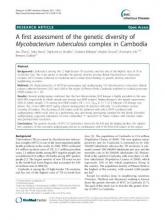
Document's year of publication: 2011-2015
Document type:
 រូបមន្តស្តង់ដារនៃការព្យាបាលជំងឺរបេង នៅក្នុងកូនសៀវភៅនេះបានរៀបចំ និងកែលំអឡើងដោយផ្អែកលើរូបមន្តណែនាំ ដោយអង្គការសុខភាពពិភពលោក... Read More
រូបមន្តស្តង់ដារនៃការព្យាបាលជំងឺរបេង នៅក្នុងកូនសៀវភៅនេះបានរៀបចំ និងកែលំអឡើងដោយផ្អែកលើរូបមន្តណែនាំ ដោយអង្គការសុខភាពពិភពលោក... Read More  In 2015, WHO reclassified the countries with a high burden of TB from 22 high TB burden countries in the previous list to 30... Read More
In 2015, WHO reclassified the countries with a high burden of TB from 22 high TB burden countries in the previous list to 30... Read More  The National Strategic Plan (NSP) to End TB 2021-2030 sets out the directions and key initiatives that the National Centre for... Read More
The National Strategic Plan (NSP) to End TB 2021-2030 sets out the directions and key initiatives that the National Centre for... Read More  This year, 2021, was still a challenging year for the National Tuberculosis Program (NTP) of Cambodia to smoothly implement... Read More
This year, 2021, was still a challenging year for the National Tuberculosis Program (NTP) of Cambodia to smoothly implement... Read More  សៀវភៅបណ្តុះបណ្តាលនេះ ពិតជាឯកសា រសំខាន់សម្រាប់បុគ្គលិកសុខាភិបាលដែលបំរើការងារប្រយុទ្ធនឹងជំងឺរបេងកុមារ នៅគ្រប់លំដាប់ថ្នាក់... Read More
សៀវភៅបណ្តុះបណ្តាលនេះ ពិតជាឯកសា រសំខាន់សម្រាប់បុគ្គលិកសុខាភិបាលដែលបំរើការងារប្រយុទ្ធនឹងជំងឺរបេងកុមារ នៅគ្រប់លំដាប់ថ្នាក់... Read More 
Document's year of publication: 2011-2015
Document type: